
Arthur Robert Ashe Jr. was an American professional tennis player who won three Grand Slam singles titles. He was the first black player selected to the United States Davis Cup team and the only black man ever to win the singles title at Wimbledon, the US Open, and the Australian Open. He retired in 1980. He was ranked world No. 1 by Harry Hopman in 1968 and by Lance Tingay of The Daily Telegraph and World Tennis Magazine in 1975. In the ATP computer rankings, he peaked at No. 2 in May 1976.

The Appomattox Court House National Historical Park is a preserved 19th-century village in Appomattox County, Virginia. The village is famous for the site of the Battle of Appomattox Court House, and contains the house of Wilmer McLean, where the surrender of the Army of Northern Virginia under Robert E. Lee to Union commander Ulysses S. Grant took place on April 9, 1865, effectively ending the American Civil War. The McLean House was the site of the surrender conference, but the village itself is named for the presence nearby of what is now preserved as the Old Appomattox Court House.

Virginia University of Lynchburg is a private historically black Christian university in Lynchburg, Virginia. The university is accredited by the Transnational Association of Christian Colleges and Schools and offers instruction and degrees, primarily in religious studies, including a Doctorate of Ministry program. The campus is a historic district listed on the National Register of Historic Places.

Jackson Ward is a historically African-American district in Richmond, Virginia with a long tradition of African-American businesses. It is located less than a mile from the Virginia State Capitol, sitting to the west of Court End and north of Broad Street. It was listed as a National Historic Landmark District in 1978. "Jackson Ward" was originally the name of the area's political district within the city, or ward, from 1871 to 1905, yet has remained in use long after losing its original meaning.

Kenmore, also known as Kenmore Plantation, is a plantation house at 1201 Washington Avenue in Fredericksburg, Virginia. Built in the 1770s, it was the home of Fielding and Betty Washington Lewis and is the only surviving structure from the 1,300-acre (530 ha) Kenmore plantation.
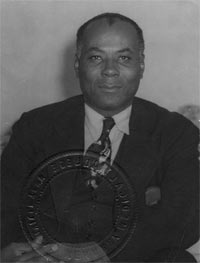
Robert Walter Johnson was an American physician and founder of the American Tennis Association Junior Development Program for African-American youths, where he coached and fostered the careers of Arthur Ashe and Althea Gibson.

The Anne Spencer House, in Lynchburg, Virginia, United States was, from 1903 to 1975, the home of Anne Spencer, a poet of the Harlem Renaissance.
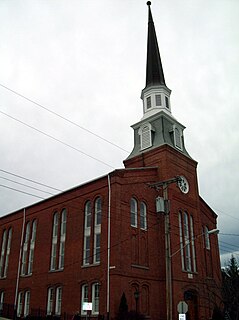
The tallest object on the downtown skyline of Lynchburg, Virginia, Court Street Baptist Church stands as a testament to the black Baptist population of Lynchburg. Organized in 1843, the congregation—originally known as the African Baptist Church of Lynchburg—was the first of its kind in the city. The church was designed by R.C. Burkholder, and completed in 1880.

The Old City Cemetery is a historic cemetery in Lynchburg, Virginia. It is the oldest municipal (city-owned) cemetery still in use today in the state of Virginia, and one of the oldest such burial grounds in the United States. Since the 1990s it has been operated as a history park and arboretum, in addition to being an active cemetery.

Carter Glass House is a historic house at 605 Clay Street in Lynchburg, Virginia. Built in 1827, it is nationally significant as the longtime home of United States Congressman, Senator, and Treasury Secretary Carter Glass (1858-1946), who championed creation of the Federal Reserve System and passage of the Glass-Steagall Act, which constrained banking activities. The house was designated a National Historic Landmark in 1976. It now serves as a parish hall for the adjacent St. Paul's Church.

Point of Honor is an historic home, now a city museum, located in Lynchburg, Virginia. The property has commanding views of the city and the James River. Its name originated due to the land on which it is built being used as a clandestine dueling ground.

John Marshall Warwick House is a historic home located at Lynchburg, Virginia. It was built in 1826 by prominent Lynchburg tobacconist and city mayor (1833), John Marshall Warwick. It was one of the first houses to be built on the crest of Lynchburg Hill, later to be called Court House Hill, overlooking the James River. It exhibits the transition from the Federal to the Greek Revival styles. His grandson, United States Senator John Warwick Daniel was born in this home.

Rosedale, a historic property comprising the Graves Mill ruins, Christopher Johnson Cottage, and Rosedale mansion, is located at Lynchburg, Virginia. The Rosedale property contains two buildings of major importance, the ruins of an 18th-century grist mill, and numerous subsidiary buildings. The earliest structure remaining is the Christopher Johnson Cottage, dating from ca. 1764 to 1774. The small, 1 1/2-story frame structure has long been known as the Johnson Cottage. The Rosedale mansion was erected in 1836 by Odin Clay, the first president of the Virginia and Tennessee Railroad, and is a two-story, three-bay, brick home laid in Flemish bond. The house was enlarged in 1929; a three-bay brick wing was added the original house. It was designed by Lynchburg architect Stanhope S. Johnson, who is best known for designing the Allied Arts Building.
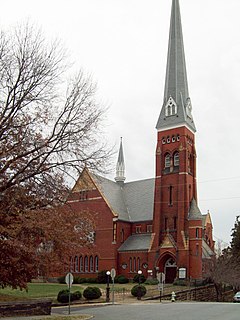
First Baptist Church is a historic Baptist church located at 1100 Court Street, Lynchburg, Virginia. It is built of hard-pressed red brick on a rough granite foundation. The main facade of the church, facing Eleventh Street, and the two sides are centered with large rose windows framed within Gothic arches covered with hood moldings. Construction began in 1884 and the church was dedicated in 1886. In the 1920s, Lynchburg architect Stanhope S. Johnson designed the complementary Sunday School annex. In 1941, the interior of the sanctuary was modified by Stanhope S. Johnson, with the creation of a divided chancel. It is home to the oldest Baptist congregation of Lynchburg, established in July 1815. Current as of 2020, First Baptist Church is affiliated with the Cooperative Baptist Fellowship (CBF).

The Lynchburg Courthouse is a historic courthouse building located at Lynchburg, Virginia. Built in 1855, it occupies a prominent position overlooking the steeply descending steps of Monument Terrace. The building is executed in stucco-over-brick on a granite ashlar basement and is an example of the Greek Revival. The building is capped by a shallow dome located over the intersection of the ridges. At the top of the dome is a small open belfry consisting of a circle of small Ionic columns supporting a hemispherical dome. The front of the court house has a three-bay Doric portico.
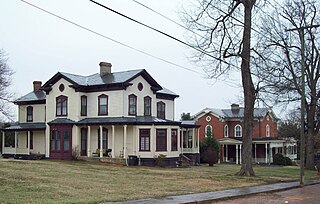
The Daniel's Hill Historic District is a national historic district located in Lynchburg, Virginia.
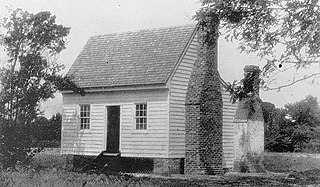
Walter Reed Birthplace is a historic home located near Belroi, Gloucester County, Virginia. It was built around 1825, and is a one-story, gable roofed frame dwelling. It has a rear shed addition. The house was restored in 1927 and again in 1970. It was the birthplace of Dr. Walter Reed.

Fifth Street Historic District is a national historic district located at Lynchburg, Virginia. The district encompasses 57 contributing buildings and 1 contributing object in a historically African-American section of Lynchburg. It includes a variety of residential, commercial, and institutional buildings, with about half dating to the period spanning from 1875 to 1940. Located in the district are the separately listed Kentucky Hotel, the Western Hotel, the William Phaup House, and the Pyramid Motors building. Other notable buildings include the Augustine Leftwich House, tobacco factories (1877-1885), the Humbles Building (1915), M.R. Scott Meat Market (1919), Miller Tire and Battery Company (1927), Adams Motor Company building (1927), Hoskins Pontiac (1951), Burnett Tire Company (1956), Moser Furniture Company building (1936), Fifth Street Baptist Church (1929), Community Funeral Home (1922), and Tal-Fred Apartments (1940).

The Pierce Street Historic District is a residential historic district in Lynchburg, Virginia. The district consists of two blocks of Pierce Street, and one adjoining block each of Fillmore and Buchanan Streets. The area consists of mostly vernacular houses with some Folk Victorian and Craftsman styling. Most of this housing stock was built before 1950. The neighborhood was developed as a small enclave of African-Americans which was otherwise surrounded by white neighborhoods. The area is notable for producing a number of significant African-American intellectuals, including Anne Spencer, a poet whose house is separately listed on the National Register. Also located in the district is the Dr. Robert Walter Johnson House and Tennis Court.
Juan Farrow is a prominent African-American tennis player and coach. He was launched in his tennis career by a neighbor in Lynchburg, Virginia, Dr. Robert Walter Johnson, who also mentored Arthur Ashe and Althea Gibson.























